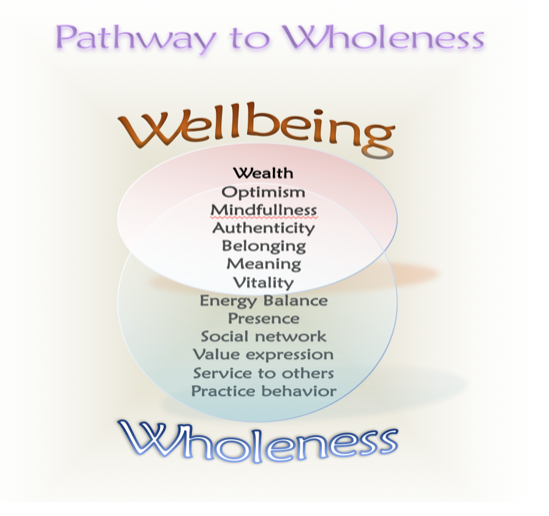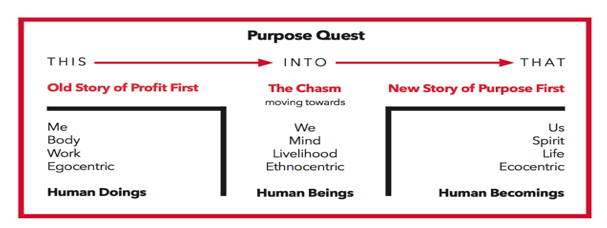I assume that you have read the first blog and have an understanding of what a curated blog is and how to use it. So, now we dig down into the how and why of it. As with any exploration into what is new territory for most of you, let’s start with defining some key terms and getting at peek at the ‘so what can I do?’ question.
What is well-being and how does that relate to wholeness?
They’re often used interchangeably, but a workplace that supports wholeness will have a lot more mileage than one that merely supports well-being. It is becoming increasingly clear in the research world that we have three overlapping things going on here. Well often means physiological health; wellbeing our emotional state and psychology; wholeness being left to the realm of authenticity and spirituality. Don’t worry I’ll cover all of these as you follow through these blogs. But for now let’s get started with a firm foundation.
So, how does this relate to my J-O-B, my work?
The boundary between working and living is disappearing and most people don’t know how to manage themselves, or their teams, in this now seamless environment. The Tayloristic notion that “you leave your personal life at the workplace doorway” doesn’t have any legitimacy in today’s world. This “new normal” is touching almost everyone. Currently, nearly 25 million people work at least one day a week in their home. This figure is growing at about four percent per year, so the boundary between working and living is rapidly disappearing.
The boundary between working and living is disappearing and most people don’t know how to manage themselves, or their teams, in this now seamless environment.
The workplace is really only an extension of the rest of our life environment. For example, if you are pushing hard on a healthy diet, why should you put that aside when you go to work? If you are really serious, you can’t. For you, the workplace needs to provide healthy eating options.
You spend about a third of your life in a work environment. If you’re striving to bring wholeness to your life, it can’t be done only outside of work. It has to be integrated into the total fabric of your life.
Exploring the difference between well-being and wholeness
But what about the larger picture? “Well-being” is the term being bandied about as the large picture idea. But is it enough to be comfortable, healthy, and happy at work? Yes, there are positive business benefits to “well-being” programs — that I’ve explored before. But I would offer that well-being and wholeness are different things. Well-being brings you balance in the present. Wholeness pulls you toward the future.
Well-being is a necessary — but not sufficient — idea to promote the growth, resiliency, and totality of a person. Wholeness is more than physical. It’s the emotional connection reflected in company purpose (or culture, if you must), brand, and an individual’s true north. Take a look at this picture:

You may notice that I have excluded wealth from the concept of wholeness. Some people may quibble with that, but if the workplace isn’t generating wholeness, no amount of compensation will matter. Money, physical things, and possessions beyond a level of simple physical comfort won’t bring wholeness to your life. Pope Francis and the Dalai Lama certainly are wealthy people in the everyday sense, but they are also living examples of wholeness in the person.
So, How Do You Get There?
Presence is very important, in the sense that you know how others perceive you and that you can also be present in the moment. To me your connection to your real life social network (not just the one on Facebook) is part of wholeness. In fact, the structure of your social network has been shown to relate directly to your emotional states.
Your ability to express your values also builds trust with your team and reinforces collaborative behavior. In a larger sense, wholeness comes from being in service to others and something larger than yourself. Finally, do you practice what you believe? If the workplace hinders true, open expression, and constrains behavior, I submit it is not contributing to wholeness.
So what can workplace leaders do to promote wholeness for their employees? It’s more than designing an attractive, comfortable space; it’s also designing the “social space” of the workplace. The word for this approach is “socio-technical” design and it seeks to jointly optimize technology (which includes the physical space) with the social, or interaction space.
What leaders can do to promote more wholeness
There are four primary actions, which leaders can take to begin the process of fostering wholeness in the workplace:
- Pay attention, listen, and observe
- Provide support for the whole person (meditation, nursing, and person-controlled privacy space)
- Spend time aligning individual purpose with company purpose
- Provide an exit path for those not motivated by purpose and wholeness
Now, you might be thinking,
That sure sounds nice, but what does it mean for the business’s bottom line?
Put another way, what does the organization get in return for giving workers a greater sense of wholeness? Based on the research I’ve done through the years; it can be shown that you get:
- More engaged employees
- Lower cost through reduction in levels of control and increased span of control
- A place that attracts and draws in highly motivated people
In fact, I believe that ‘wellbeing’ and her handmaiden ‘wholeness’ will be the biggest talent development issue for the next decade. The reason is that we are in the midst of a larger environmental shift from the OLD story of command and control to the NEW Story of collaboration and nurturance. We are moving from ‘this into that’:

Ultimately, this is about taking personal leadership for realizing your wholeness, centered on purpose. The process of realizing wholeness begins with the individual but it also extends way beyond the person into the workplace and the larger community. What is important is that there are no barriers to wholeness in the workplace.
Ideally, we will have workplaces in the future that not only have taken down barriers, but also actually promote a commitment to wholeness. The workplace can provide a container to do this for those who are seeking it.


Leave A Comment
You must be logged in to post a comment.